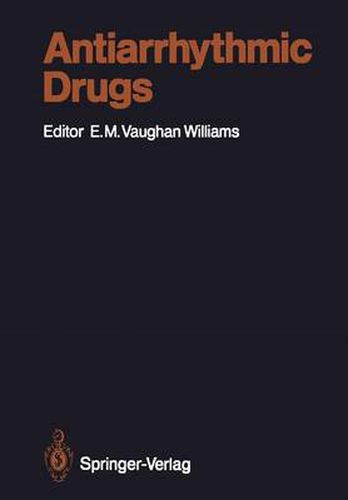Readings Newsletter
Become a Readings Member to make your shopping experience even easier.
Sign in or sign up for free!
You’re not far away from qualifying for FREE standard shipping within Australia
You’ve qualified for FREE standard shipping within Australia
The cart is loading…






This title is printed to order. This book may have been self-published. If so, we cannot guarantee the quality of the content. In the main most books will have gone through the editing process however some may not. We therefore suggest that you be aware of this before ordering this book. If in doubt check either the author or publisher’s details as we are unable to accept any returns unless they are faulty. Please contact us if you have any questions.
The development of a new antiarrhythmic drug involves many people with disparate skills. The organic chemist who makes it is guided not only by the structure-action relations of previous compounds, but by anticipation of a requirement for a particular type of action. In fact several of the best-known antiarrhythmics, including lidocaine, mexiletine, amiodarone and verapamil, were originally synthesized for other purposes. Physicians have to determine whether the new drug works, and pharma cologists how it works. For some years I have believed that there was room for a work which could be understood by all these groups and which could enlighten each about the point of view of the others. Thus when I was invited by Springer-Verlag to prepare a volume in their series Handbook of Experimental Pharmacology, I already had a firm conception of what its form should be. In any multi-author work there are two objectives which cannot always readily be reconciled. The first is to select topics which would relate to each other in a coherent manner. to give a logical and orderly shape to the volume as a whole. The second is to offer authors the greatest possible freedom to express themselves as they wish. When the general design was complete, prospective contributors were invited to write specific chapters, being provided with a complete list of their coauthors and chosen topics, so that they could avoid overlap.
$9.00 standard shipping within Australia
FREE standard shipping within Australia for orders over $100.00
Express & International shipping calculated at checkout
This title is printed to order. This book may have been self-published. If so, we cannot guarantee the quality of the content. In the main most books will have gone through the editing process however some may not. We therefore suggest that you be aware of this before ordering this book. If in doubt check either the author or publisher’s details as we are unable to accept any returns unless they are faulty. Please contact us if you have any questions.
The development of a new antiarrhythmic drug involves many people with disparate skills. The organic chemist who makes it is guided not only by the structure-action relations of previous compounds, but by anticipation of a requirement for a particular type of action. In fact several of the best-known antiarrhythmics, including lidocaine, mexiletine, amiodarone and verapamil, were originally synthesized for other purposes. Physicians have to determine whether the new drug works, and pharma cologists how it works. For some years I have believed that there was room for a work which could be understood by all these groups and which could enlighten each about the point of view of the others. Thus when I was invited by Springer-Verlag to prepare a volume in their series Handbook of Experimental Pharmacology, I already had a firm conception of what its form should be. In any multi-author work there are two objectives which cannot always readily be reconciled. The first is to select topics which would relate to each other in a coherent manner. to give a logical and orderly shape to the volume as a whole. The second is to offer authors the greatest possible freedom to express themselves as they wish. When the general design was complete, prospective contributors were invited to write specific chapters, being provided with a complete list of their coauthors and chosen topics, so that they could avoid overlap.